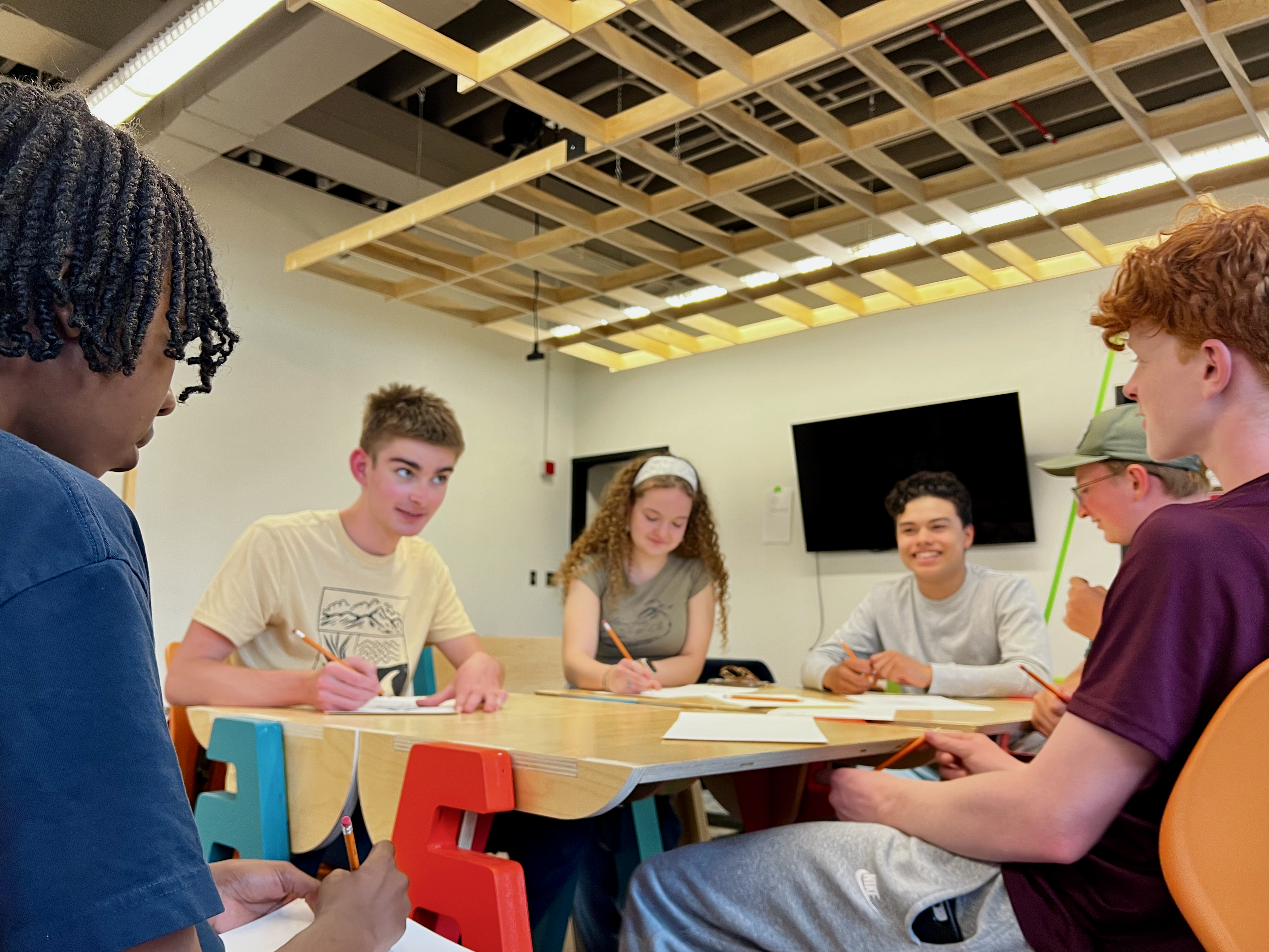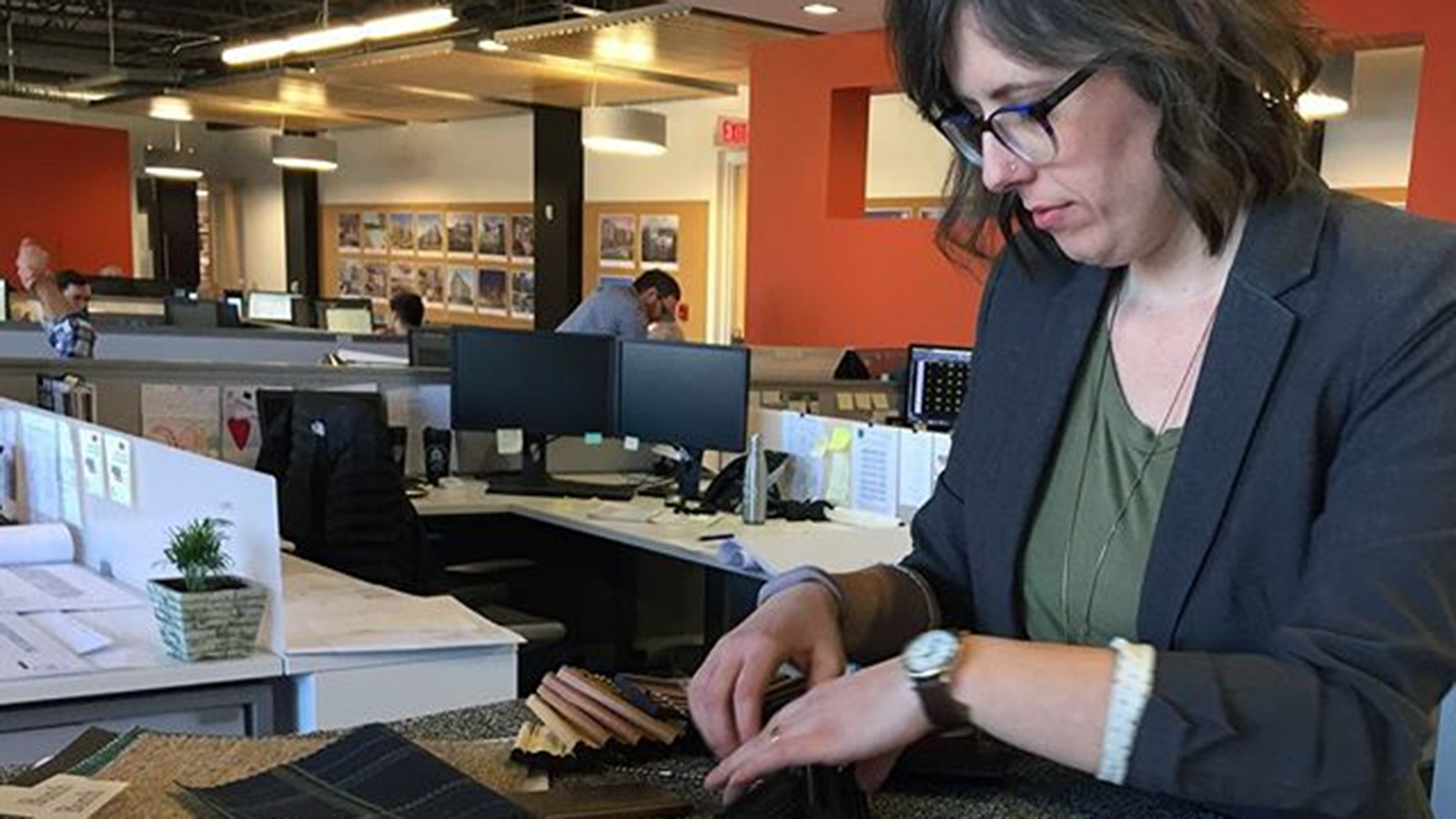Do you see the world not just as it is—but as it could be?
At Ohio State Design, our Interior Design program empowers you to reimagine the spaces where people live, work, learn, and heal. Whether you're inspired by the energy of a bustling workplace, the calm of a healing environment, or the elegance of a hospitality space, this is where your vision becomes reality.
You’ll explore how human needs, environmental conditions, and spatial opportunities intersect—learning to design interiors that are not only beautiful, but functional, inclusive, and sustainable. Through a powerful blend of design studios and hands-on coursework, you’ll gain the technical skills, theoretical knowledge, and research-driven mindset needed to become a leader in the field.
From day one, you’ll be immersed in collaborative, real-world design challenges that prepare you to shape commercial, educational, healthcare, and private environments of all scales. And when it’s time to graduate, your final project will showcase your ability to think independently, design with purpose, and create spaces that truly make a difference.
Are you ready to design spaces that inspire and support the people who use them?
Join us at Ohio State’s Interior Design program—and start building the future, one space at a time.
What is the Interior Design Major?
The Interior Design program at The Ohio State University prepares students to design environments that enhance human experience and well-being. With a strong emphasis on commercial, workplace, hospitality, educational, and healthcare spaces, students learn to apply design thinking and research to create functional, sustainable, and aesthetically compelling interiors. The curriculum blends studio practice with technical and theoretical coursework, encouraging students to explore spatial design opportunities informed by environmental conditions and user needs. Collaboration and sustainability are key pillars of the program, helping students develop holistic approaches to interior design. Throughout their studies, students engage in real-world challenges and interdisciplinary projects, culminating in a final capstone that demonstrates their ability to work independently and lead in the field of environmental design.
"Interior Design influences how we feel, interact, work, learn and heal within the spaces we inhabit—transforming spaces into experiences."
Susan Melsop, Interior Design Coordinator
Curriculum and Course Sequence
A Collaborative First-Year Experience
All Design students begin in the 18-credit hour collaborative Design Foundations program. This is a shared first-year experience where all design students build core creative, technical, and collaborative skills before applying to their chosen major.

Second Year and Beyond...
Second Year
Autumn
- DESIGN 3102: Introduction to Interior Design I
- DESIGN 3200: Design Research I
- DESIGN 3402: Design Media I for Interior Design
Spring
- DESIGN 3152: Introduction to Interior Design II
- DESIGN 3452: Design Media II for Interior Design
- DESIGN 3502: Materials, Process, and Production for Interior Design
- DESIGN 3552: Interior Design Technology I
Third Year
Autumn
- DESIGN 4102: Intermediate Interior Design I
- DESIGN 4200: Design Research II
- DESIGN 4402: Design Media III for Interior Design
- DESIGN 4502: Interior Design Technology II
Spring
- DESIGN 4152: Intermediate Interior Design II
- DESIGN 4650: Collaborative Design
- DESIGN 5502: Interior Design Technology III
- DESIGN 5750: Advanced Design History**
Fourth Year
Autumn
Spring
- DESIGN 4752: Professional Practices for Interior Design
- DESIGN 5552: Interior Design Technology IV
- DESIGN 5650: Advanced Collaborative Design
History of Art Minor
Interior Design students* are required to complete a minor in History of Art—a meaningful collaboration between Design and the Department of History of Art that deepens creative perspective and adds value to your degree.
The minor includes five courses (15 credit hours), with Design 2750 counting toward both the major and minor. Design 5750 is a recommended upper-level option. At least two courses must be at the 4000-level or above.
This required minor doesn’t limit your academic path—you’re free to pursue additional minors and customize your experience.
* The History of Art Minor is only required for students on the GE-N curriculum. Students who started at Ohio State prior to AU2022, and are therefore on the GE-L curriculum, have a similar number of HISTART courses in their GE-L requirements.
** DESIGN 5750 is required of all Interior Design major students on Legacy GE. It is strongly recommended as one of upper-division options in required History of Art Minor for all students on New GE.
Gain Experiences & Discover Your Passion
Opportunities to become fully engaged in an experience are instrumental to discovering your passion. Internships will give you the experience you need to differentiate yourself from other candidates, support your career goals, contribute to your skill set and determine how your career exploration process and focus may need to be modified to support your long-term goals. Employers are looking for graduates that have already taken the next step to becoming professionals in their field.
Student Achievement Data
| Academic Year | Retention 1 | Avg. Time to Degree 2 | Job Placement 3 | Graduate School Acceptance 4 |
|---|---|---|---|---|
| 2024-2025 | 97% | 4.1 Years | NA | 100% |
| 2023-2024 | 100% | 4.1 Years | 11 of 18 = 61% | 100% |
| 2022-2023 | 91% | 4.2 Years | 13 of 16 = 81% | 100% |
- Percentage of students enrolled the previous academic year who returned the following year.
Source: University 15th Day Census - Average time at Ohio State for the graduating class to earn their degree in design.
Source: University Data Store - College of Arts and Sciences Reporting - Percentage of students who graduated and were employed in a full-time design job within a year of graduation.
Source: LinkedIn Audit* Not all alumni maintain LinkedIn Profiles - Percentage of students who applied to a graduate program that were accepted.
Source: LinkedIn Audit* Not all alumni maintain LinkedIn Profiles
CIDA Accreditation Status
The interior design program leading to the Bachelor of Science in Design is accredited by the Council for Interior Design Accreditation, www.accredit-id.org, 206 Grandville Avenue, Suite 350, Grand Rapids, MI, 49503.
The CIDA-accredited program prepares students for entry-level interior design practice, for advanced study, and to apply for membership in professional interior design organizations. The Bachelor of Science in Design granted by The Ohio State Univieristy meets the educational requirement for eligibility to sit for the National Council for Interior Design Qualification Examination (NCIDQ Exam). For more information about NCIDQ Exam eligibility visit: https://www.cidq.org/eligibility-requirements.
The state of Ohio does not currently require licensure or registration, to work as an Interior Designer. If you plan to pursue licensure or registration in a state other than Ohio, please review state educational requirements for licensure and registration and state licensing board contact information at go.osu.edu/onground. Many other states do already, or are working towards, requirements to attend CIDA accredited programs and/or passing the NCIDQ.


Notable Companies Hiring our Interior Designers
Here are some notable companies who have recently hired our visual communication design graduates to create functional, sustainable, and aesthetically compelling interiors that impact space users across their organizations.
- NBBJ is an American global architecture, planning and design firm with offices in Boston, Columbus, London, Los Angeles, New York, Portland, Pune, San Francisco, Seattle and Shanghai.
- Gensler is a global design and architecture firm headquartered in San Francisco, California. It is the largest architecture firm in the world by revenue and number of architects.
- Triad is a full-service architecture, construction, and development firm located in Columbus, Ohio that works across architecture, design, construction, facilities management, and real estate development services.
- Moody Nolan founded in Columbus, Ohio, in 1983, is the largest African-American-owned and operated architecture firm in the United States, with 12 offices nationwide.
- King Business Interiors is a family-owned commercial office furniture and flooring company located in Columbus, Ohio.
- Design Collective is an award winning firm with a national reputation and client base, specializing in the Corporate, Hospitality, Retail, & Senior Living markets, located in Columbus, Ohio.
- DesignGroup is an AIA Ohio Gold Medal architecture and design firm located in Columbus, Ohio and Pittsburgh, Pennsylvania. The practice is focused upon education, library, healthcare, cultural + civic, and office projects, with numerous, award-winning projects located throughout the United States.
- MA Design is a full service design firm headquartered in Columbus, OH that focuses on enriching lives through innovative design across a variety of market sectors.
- Studio Black Ink is a full-service interior design firm specializing in bespoke residential and hospitality interiors, as well as procurement services for both residential and commercial projects.
- Sketch Blue is a lively, creative studio built on collaborations between interior design + graphic design.
- JLL Design Solutions is a full-service design consultancy backed by global experts in real estate and design.
- Continental Office are experts in creating spaces that bring environments to life through furniture, interior construction, experiential design and environmental graphics, and the workplace services to inspire the passionate leaders, analytical problem-solvers, and creative go-getters who inhabit them.
- WSA is a multi-disciplinary Experience Design firm offering a unique combination of strategic consulting, architecture, interior design and graphic design services.
Professional Organizations
Professional organizations play an important role in the development of design disciplines and provide valuable resources to their student and professional members. The following organizations are all relevant to Interior Design.
- International Interior Design Association (IIDA)
- American Society of Interior Designers (ASID)
- Human Factors and Ergonomics Society (HFES)
- Retail Design Institute (RDI)
- Society for Environmental Graphic Design (SEGD)
- The American Institute of Architects (AIA)
Looking to hire a Design student?
Employers seeking to hire for internships and/or full-time opportunities are encouraged to work with the Center for Career and Professional Success to post openings via Handshake.









